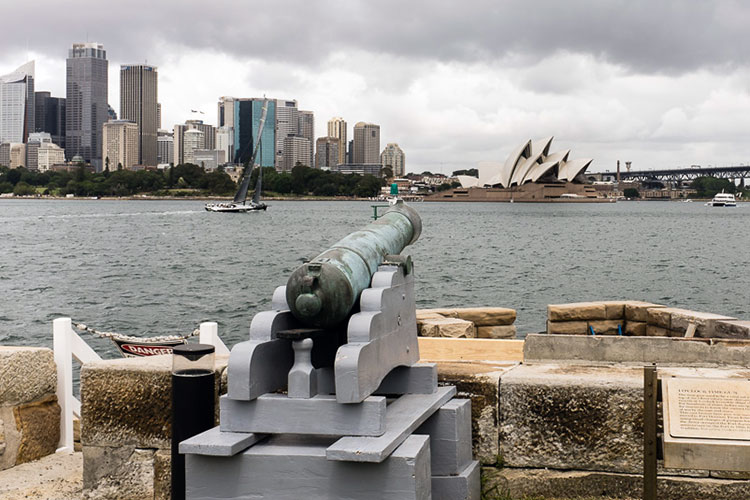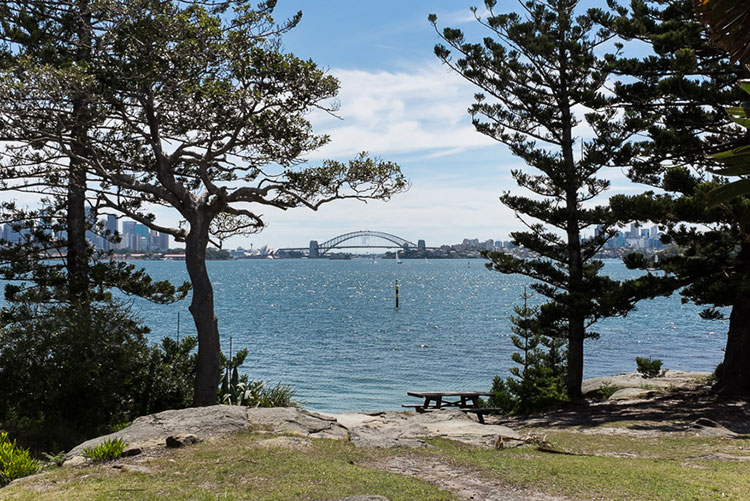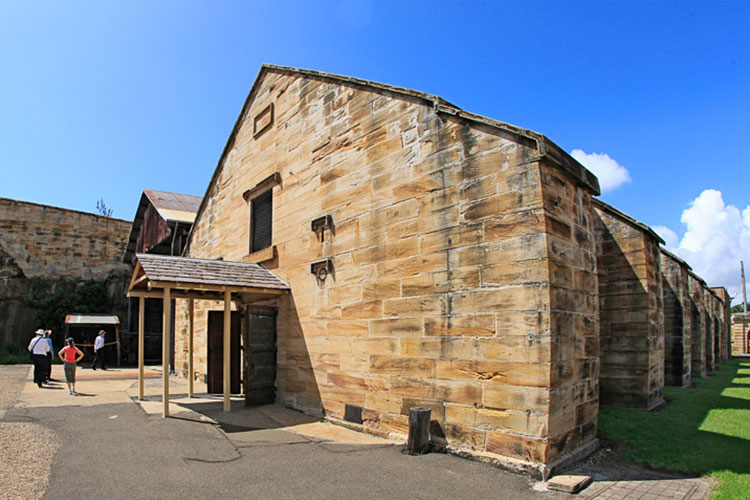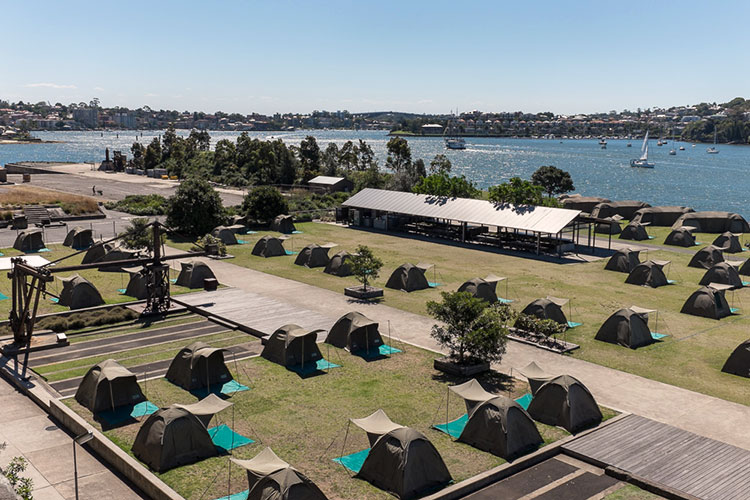That’s not the case come New Year’s Eve, though. Five islands – Fort Denison, Shark and Clark to the east of the Harbour Bridge, and Cockatoo and Goat to the west – are open to the public. They provide front-row seats (at a hefty price) for one of the world’s most spectacular fireworks displays. Here’s how you can enjoy Sydney’s historic harbour islands all year-round.

Cannon at Fort Denison pointing toward Sydney Opera House. Image by Glen Pearson / Lonely Planet.
This tiny speck is a five-minute ferry ride from Circular Quay past the world-famous Opera House, making it one of the most accessible isles. It lies between Kirribilli Point, home to the Prime Minister’s official city pad, and the Navy base at Garden Island, now joined to the mainland. When the First Fleet arrived in 1788, the local Aboriginal people knew the rocky island as Mat-te-wan-ye. It was flattened in the 1840s using convict labour. 'The island was known as Pinchgut, probably due to the spartan rations for the convicts,' says tour guide Wendy Groskops.
A fortification was later built and the honey-coloured Martello Tower was completed in 1857. A 30-minute guided tour leads you up the tower’s winding staircase to the cannon room, with impressive 360-degree views at the top. There’s an interesting little museum, daily firing of the cannon at 1pm, plus a café and pricey restaurant serving seafood and kangaroo.
Getting there: ferries depart every 45 minutes from Circular Quay and Darling Harbour (www.captaincook.com.au). Heritage Tour operates daily at 10.45am, 12.15pm and 2.30pm (www.nationalparks.nsw.gov.au).

Shark Island with a view of the Harbour Bridge. Image by Glen Pearson / Lonely Planet.
Named for its shape rather than what’s lurking below, Shark Island is a little patch of paradise located off Sydney’s most exclusive eastern suburb, Point Piper.
In the 19th century, the island was used as a quarantine area and naval storage depot, before becoming part of the Sydney Harbour National Park in the 1970s. It has palm-shaded grassy areas with tables, toilets and drinking water, but no BBQ facilities, so pack a picnic. There’s also a sandy beach that is perfect for a dip. The popular Hop On Hop Off ferry stops at Shark Island, but most daytrippers don’t disembark, so you’re likely to have your own deserted island. To avoid being a real-life Robinson Crusoe, check what time the ferries return as there are only a few per day.
Getting there: ferries depart from Circular Quay and Darling Harbour (www.captaincook.com.au). The 24-hour Hop On Hop Off pass has eight stops including Fort Denison and Shark Bay (www.captaincook.com.au).

Sandstone buildings on Goat Island. Image by NSW National Parks and Wildlife Service.
Located between McMahons Point and Balmain, Goat Island (Me-mel) was a popular fishing spot for the local Aboriginal people. It’s thought three goats from the First Fleet were put on the island to breed, hence the new name.
In the 1830s, hundreds of convicts were sent here to quarry sandstone to build a thick-walled gunpowder store. 'They were kept in appalling conditions in 3m x 2m boxes that held 20 men inside,' says tour guide Brendan Brumby. 'It’s suggested that they were whipped up to 39 times a day, as it was believed that 40 times would kill a man.'
Grisly relics of the island’s convict past remain, including a seat carved out of stone by Charles ‘Bony’ Anderson, who was sentenced to be chained to the rock for two years. 'They say you can still feel his presence near the couch today,' says Brumby.
Getting there: by guided tour or private water taxi only. Convicts, Castles and Champagne Tour runs Thu-Mon at 1pm (the tour includes the ferry, BBQ lunch and bar - www.uniquesydneycruises.com.au). Heritage Tour runs on the second Sunday of the month at 10.10am (the tour includes return ferry - (www.captaincook.com.au)).

Campsite on Cockatoo Island. Image by Glen Pearson / Lonely Planet.
Originally called Wareamah by the indigenous population, Unesco World Heritage-listed Cockatoo is the largest of all harbour islands. It sits at the junction of the Parramatta and Lane Cove Rivers, about 10 minutes by ferry from Circular Quay.
In 1839, the island was established as a prison for up to 550 men. Over the next 30 years, convicts built stone barracks, granary silos and a dry dock, which was the start of the island’s long shipbuilding heritage. From 1870 to 1992, thousands of workers built ships and eventually submarines here. Huge workshops and rusty machinery remain, giving the island an industrial edge. You can explore the island’s history on four self-guided walking trails or with an audio tour.
There are a few holiday cottages and a fantastic camping ground with BBQs, fridge and hot showers. Pitch your own tent or hire a permanent one. An old slipway makes a safe swimming spot, plus there’s a funky bar with uninterrupted views and tasty wood-fired pizzas.
Getting there: regular ferries depart from Circular Quay and Darling Harbour (www.transportnsw.info).
Off the tip of Darling Point near Double Bay, this one-hectare island is another top picnic spot with tables and toilets. It’s named after a lieutenant of the First Fleet who tried to establish a vegetable garden here, although light-fingered convicts soon put a stop to that.
Getting there: by water taxi only from Circular Quay (www.h2owatertaxis.com.au); visitors pay a landing fee and bookings are essential (www.nationalparks.nsw.gov.au).
In the calm waters of Iron Cove, Rodd Island is the farthest west of all the harbour islands. Named after a solicitor, the half-hectare island was used a biological laboratory in the 19th century. It has picnic tables, loos and several historic buildings to explore, including a colonial dance hall.
Getting there: by water taxi only from Circular Quay (www.h2owatertaxis.com.au); visitors pay a landing fee and bookings are essential (www.nationalparks.nsw.gov.au).
Spectacle Island, a stone’s throw from Cockatoo Island, is a working naval base and is not usually open to the public. Nearby Snapper Island, the smallest island in Sydney Harbour, was used as a nautical training facility in the 1930s and is currently closed to the public.